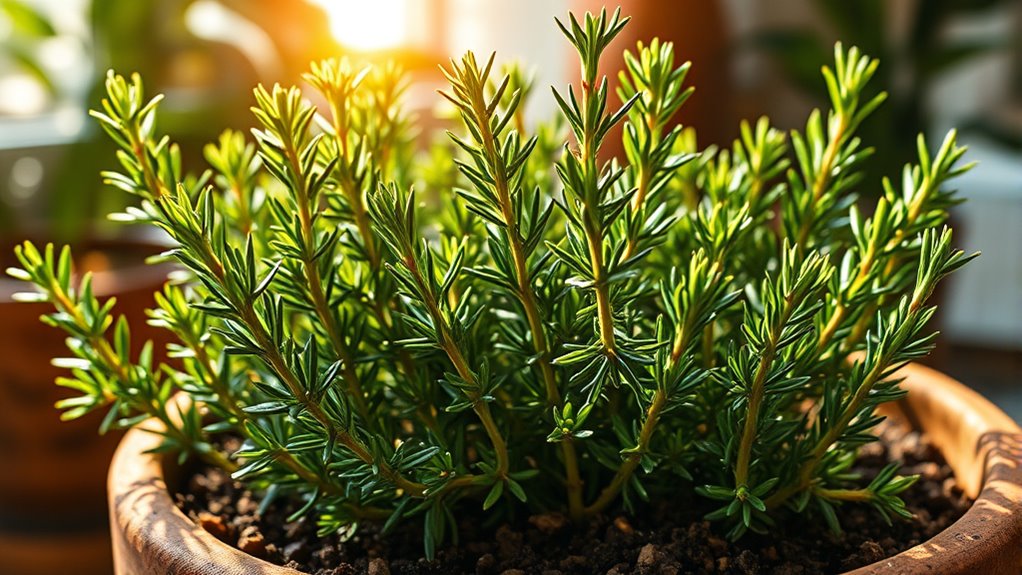To grow rosemary indoors, guarantee it gets at least 6 hours of direct sunlight daily by placing it near south-facing windows or using grow lights. Use well-draining soil with a pH around 6.5 to 7.0, and make sure your container has drainage holes. Water only when the top inch of soil dries out, and keep the temperature between 50°F and 80°F. Curious about more tips to keep your rosemary thriving year-round?
Key Takeaways
- Provide at least 6 hours of direct sunlight daily, preferably near south-facing windows or with supplemental full-spectrum LED grow lights.
- Use well-draining, organic-rich soil with a pH of 6.5–7.0 and ensure containers have drainage holes for excess water.
- Water only when the top inch of soil dries out, adjusting frequency seasonally, and avoid overwatering to prevent root rot.
- Maintain indoor temperatures between 50°F and 80°F, and keep humidity levels around 30-50% with proper ventilation.
- Adjust lighting and watering routines seasonally, using grow lights during shorter days and reducing watering in winter.
Selecting the Ideal Sunlight Conditions for Indoor Rosemary

To guarantee your indoor rosemary thrives, providing sufficient sunlight is essential. Indoor rosemary needs at least 6 hours of direct sunlight daily for ideal growth. Position your plant near a bright windowsill, preferably south-facing, to maximize natural light exposure. Utilizing vertical storage solutions can help optimize space around your plant, ensuring it receives unobstructed light. Full sun is perfect, but if natural sunlight falls short, supplement with a grow light—preferably full-spectrum LED—to prevent legginess and weak stems. During winter or low-light seasons, extend grow light exposure to 10-14 hours daily to mimic Mediterranean sun conditions. Use a PAR or light meter to monitor light intensity, aiming for around 500 μmol/m²/s PPFD. Avoid shaded areas or east-facing windows that receive limited morning sun, ensuring your indoor rosemary gets consistent, adequate light for healthy development. Additionally, understanding light requirements can help you better tailor your indoor gardening setup for optimal rosemary growth. Incorporating artificial lighting is a practical solution when natural light is insufficient.
Choosing the Right Soil Composition and Ph Levels
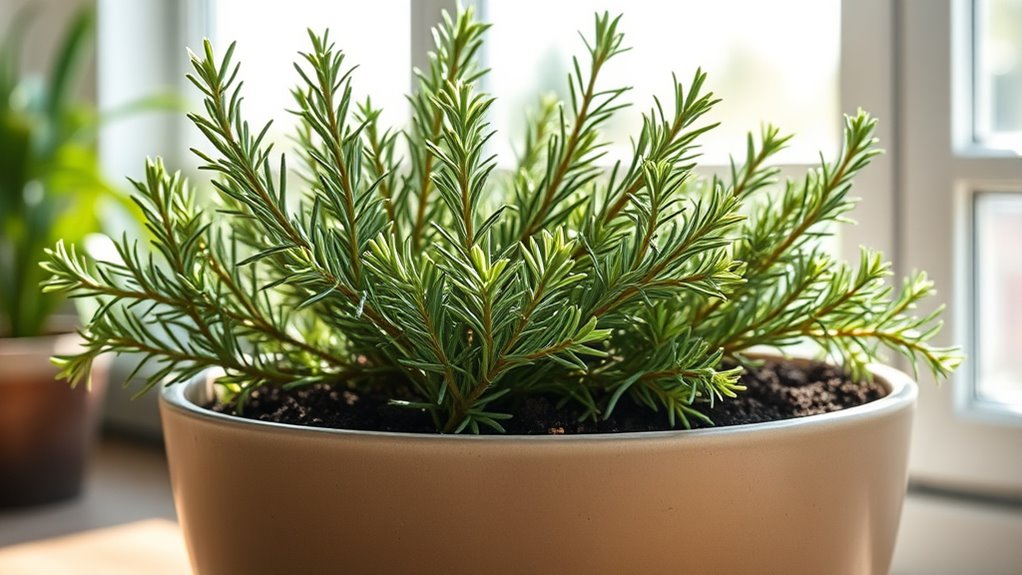
Selecting the appropriate soil composition is essential for healthy indoor rosemary growth, as the plant thrives in well-draining, organic-rich substrates. Use amended potting soil or a sandy cactus mix to guarantee good drainage and aeration.
Choose well-draining, organic-rich soil like amended potting mix or cactus soil for healthy indoor rosemary.
Incorporate organic matter like compost or manure to boost soil fertility and provide essential nutrients.
Regularly test the soil pH with a reliable meter to maintain a slightly acidic to neutral range of 6.5 to 7.0, which is ideal for rosemary.
Adding coarse sand or gravel improves aeration and prevents water from sitting around the roots, reducing the risk of root rot.
A balanced soil composition that combines these elements supports strong growth and ensures your rosemary stays healthy indoors.
Ensuring Proper Drainage to Prevent Root Rot
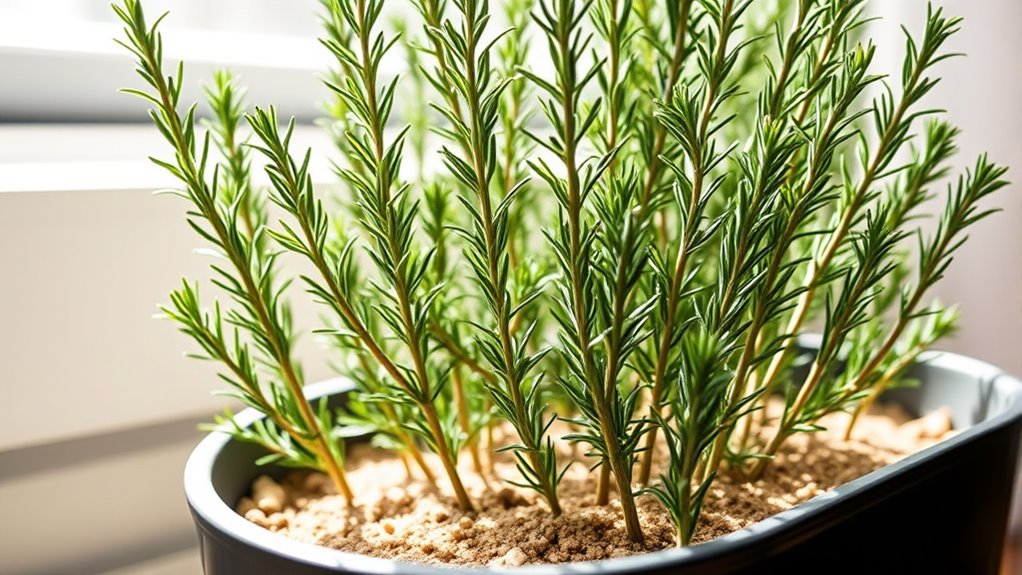
Ensuring proper drainage is vital for preventing root rot in your indoor rosemary. Start with containers that have drainage holes to allow excess water to escape easily. Use a well-draining soil mix that includes coarse materials like sand or gravel to improve aeration and prevent waterlogging. Avoid overwatering; always check that the top inch of soil is dry before watering again. Elevating your pot on pot feet or placing a layer of small stones underneath helps enhance drainage and reduces standing water. Proper drainage prevents excess moisture from sitting around the roots, which is essential for healthy growth. Incorporating drainage techniques such as adjusting watering habits and container choices can help you better understand your plant’s needs. Additionally, considering the diverse water attractions available at local water parks can inspire creative ways to incorporate water management in your gardening routine. Without it, your rosemary is at risk of developing root rot, so prioritize these drainage strategies to keep your plant thriving indoors.
Optimizing Watering Practices for Healthy Growth
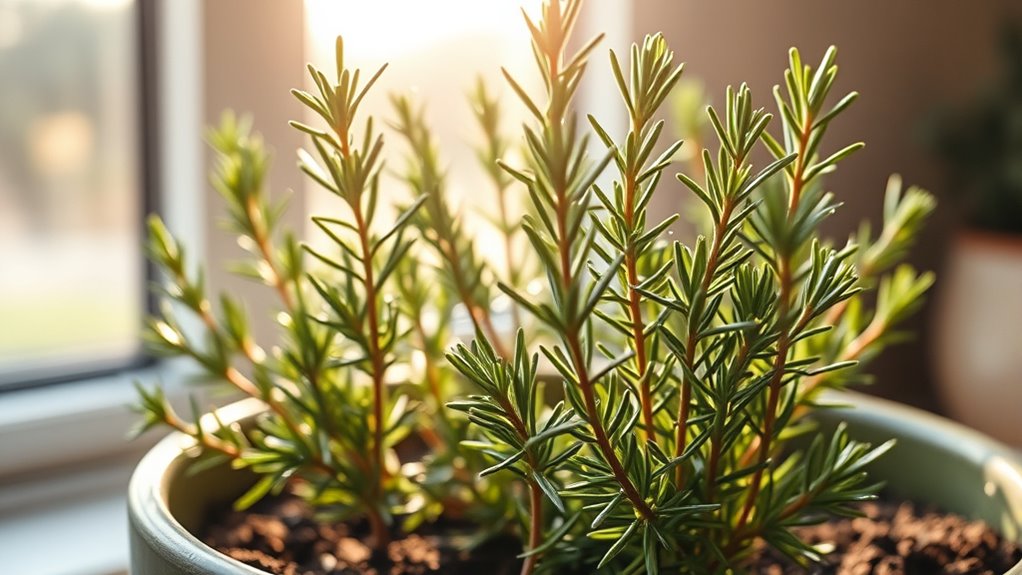
Proper watering practices are key to keeping your indoor rosemary healthy and vibrant. To do this, check the top inch of soil; only water when it feels dry to prevent root rot and overwatering. Use well-draining soil and pots with drainage holes to guarantee excess water escapes, promoting healthy roots. Monitoring indoor air quality can also help maintain optimal plant health by preventing issues caused by stale or stagnant air. During the growing season, increase watering frequency in warmer months but always wait until the soil dries out between waterings. In winter, reduce watering, providing just enough moisture to keep the soil slightly moist. Lightly mist the foliage every 10 days to maintain humidity without creating excess moisture that can lead to fungal issues. Adjusting your watering practices based on soil moisture levels and season, along with considering plant health factors, will help support healthy rosemary growth indoors. Incorporating air purifier features like HEPA filtration can improve indoor air quality, which is beneficial for both your plants and living space. Additionally, understanding the soil composition can further optimize watering routines to suit your rosemary’s specific needs.
Managing Indoor Temperature and Humidity
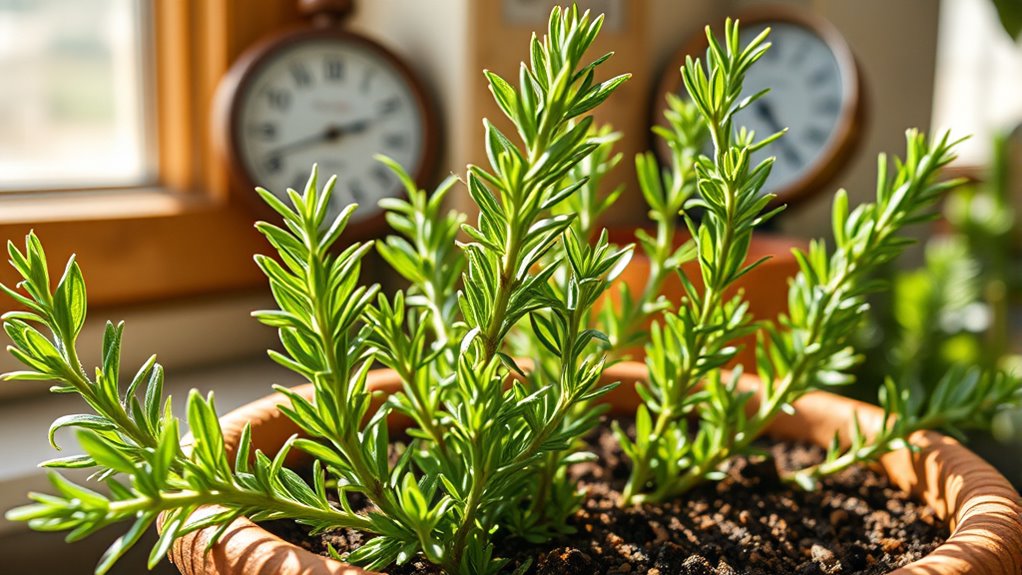
Maintaining stable indoor temperature and humidity is essential for healthy rosemary growth, especially since fluctuations can stress the plant. Keep your indoor temperature between 50°F and 80°F, with a target of around 70°F. Avoid sudden temperature fluctuations by keeping the plant away from cold drafts, heating vents, and cold windows during winter. Since a dry indoor environment can hinder growth, use pebble trays filled with water beneath your pot to boost humidity levels. Regularly monitor humidity with a hygrometer, aiming for 30-50%, to prevent issues like powdery mildew. During winter, gradually acclimate your rosemary to indoor conditions to help it adapt. Proper moisture control and maintaining good indoor air quality ensure your rosemary stays healthy and thrives indoors. Additionally, be attentive to indoor air quality as poor air circulation can also negatively impact plant health. Ensuring proper ventilation can help prevent mold and other issues that may arise from stagnant air, and incorporating air purifiers can further improve the environment for your plant. Maintaining adequate humidity levels is crucial, as dry air can cause leaf browning and stress in rosemary. For optimal growth, consider using humidifiers to maintain consistent moisture levels in the air.
Positioning Your Rosemary for Maximum Light Exposure
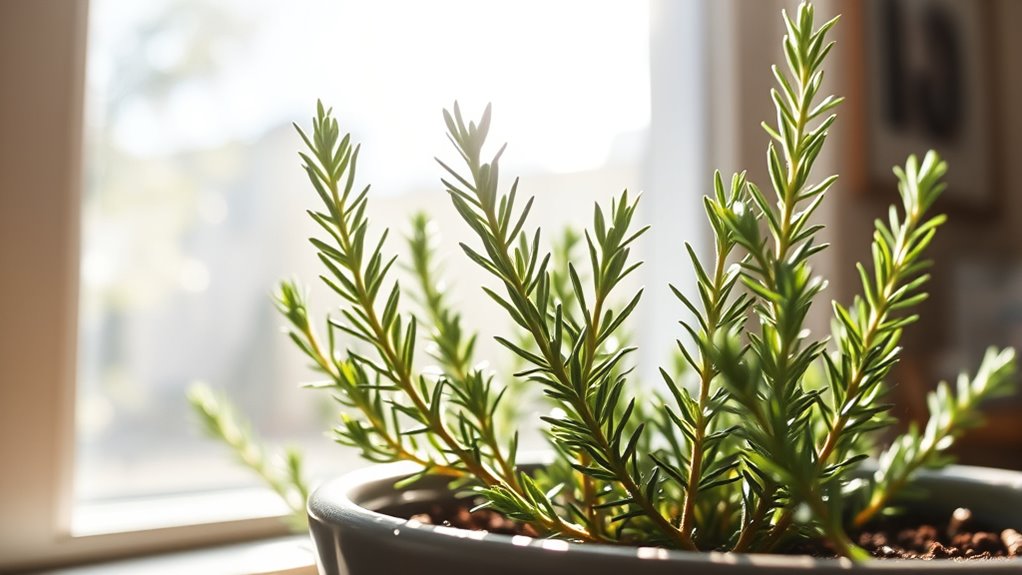
To give your rosemary the best light, place it near south or east-facing windows where it can get at least 6-8 hours of direct sunlight each day. If natural light is limited, use full-spectrum LED grow lights about 6 inches above the plant to guarantee it gets enough brightness. Be sure to rotate the plant weekly and keep it away from cold drafts or shady spots that can hinder its growth. Additionally, ensuring your rosemary has the appropriate lighting conditions can significantly improve its health and growth rate, and understanding cost and budgeting can help you plan for any necessary equipment or modifications. Monitoring your plant’s environment for sustainability and making adjustments as needed can foster a thriving indoor herb garden. Incorporating natural materials in your setup can further enhance the overall health of your indoor garden while maintaining an eco-friendly space.
Choose South or East Windows
Choosing the right window for your rosemary can make a big difference in its growth. South-facing windows are ideal because they provide at least 6 hours of direct sunlight daily, promoting healthy indoor growing. Sunlight exposure can also help you better understand your plant’s needs and respond accordingly. East-facing windows offer gentle morning sun, which still supplies consistent light exposure if a south-facing spot isn’t available. When selecting your window, consider these tips: – Place your rosemary near south-facing windows for maximum sunlight – Use east-facing windows if natural light is limited – Avoid shaded areas from trees, buildings, or curtains – Rotate the plant regularly to prevent legginess – Supplement with grow lights if sunlight is insufficient Proper window placement ensures your rosemary receives the necessary sunlight, encouraging a lush, bushy shape and healthy growth indoors. Additionally, understanding the importance of indoor gardening can help optimize your plant care routines for better results.
Use Grow Lights Effectively
Positioning your grow lights correctly is key to maximizing your rosemary’s growth. Keep full-spectrum LED grow lights about 6 inches above the plant to deliver a PPFD of around 500 μmol/m²/s, supporting healthy photosynthesis. Use a grow lights on timer for 10-14 hours daily to mimic natural light cycles. To guarantee even light exposure, place rosemary in a south-facing window or under lights that distribute light uniformly. Regularly adjusting the height and angle of your grow lights maintains consistent, direct light as the plant grows taller. Proper light distribution prevents legginess and encourages bushy growth. Here’s a quick guide:
| Aspect | Tip | Reason |
|---|---|---|
| Light Height | 6 inches above | Ideal PPFD |
| Timer | 10-14 hours daily | Mimics sunlight |
| Light Type | Full-spectrum LED | Supports growth stages |
| Adjustment | Regularly adjust | Maintains light exposure |
Consistent light management not only promotes healthy growth but also aligns with best practices for indoor plant cultivation.
Avoid Cold Drafts
Ensuring your rosemary stays healthy involves more than just providing ample light; you also need to protect it from cold drafts that can stress the plant. Cold drafts and temperature fluctuations can harm your rosemary, so avoid placing it near open windows, exterior doors, or vents.
To prevent cold air intrusion, use draft stoppers or weather-stripping on windows and doors, especially during winter. Keep the plant away from areas with poor air circulation or where cold air from vents blows directly onto it, which can cause leaf damage.
Consider positioning the rosemary slightly away from exterior walls or drafty openings, and supplement with grow lights if natural light is limited. Proper positioning helps maintain a stable indoor environment, promoting healthy growth.
Using Artificial Lighting to Supplement Sunlight
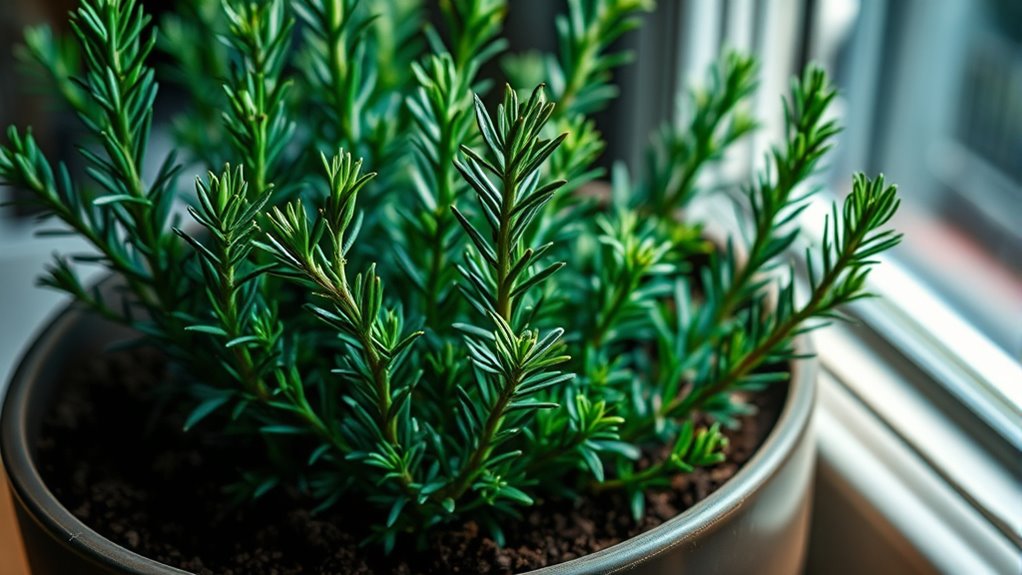
When natural sunlight falls short, artificial lighting can effectively supplement your rosemary’s needs. Using grow lights, especially full-spectrum LED options, assures your plant receives the necessary light for healthy growth.
Position your grow lights about 6 inches above the plant to achieve a Photosynthetic Photon Flux Density (PPFD) of around 500 μmol/m²/s, which optimizes photosynthesis. Setting a timer for 10-14 hours daily mimics natural daylight, promoting vigorous growth.
Position grow lights 6 inches above for optimal photosynthesis and 10-14 hours daily to boost rosemary growth.
Choose high-quality grow lights that provide a balanced spectrum, including blue and red wavelengths, to support plant processes. Combining artificial lighting with natural light, such as from south-facing windows, guarantees your rosemary gets enough light for successful indoor cultivation year-round.
Proper lighting is essential for thriving rosemary indoors.
Adjusting Watering and Light During Seasonal Changes
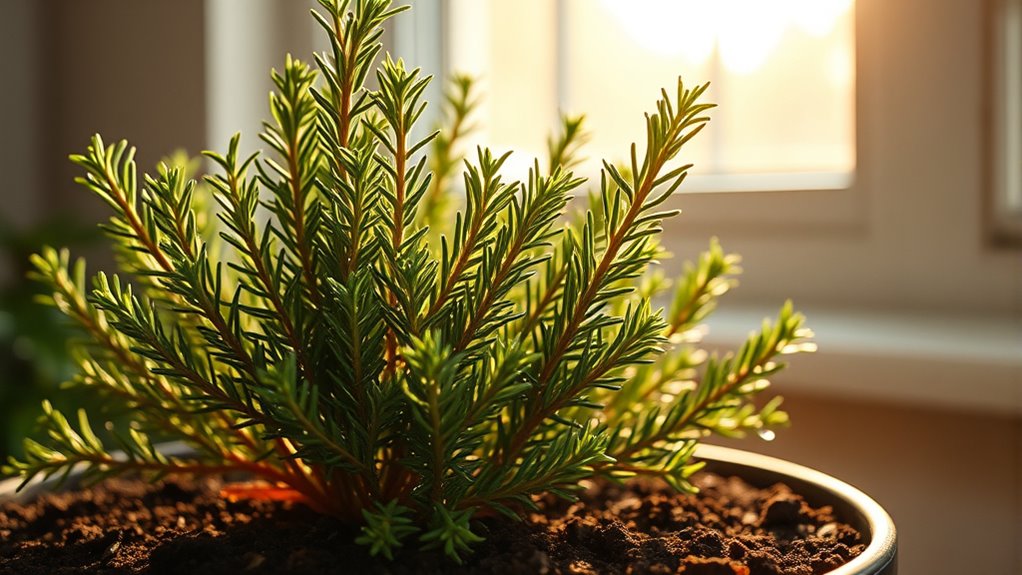
As the seasons change, you’ll need to adjust your watering and lighting routines to keep your rosemary healthy. During winter, reduce watering to prevent root rot, letting the soil dry out completely between waterings. Supplement natural light with grow lights for at least 14 hours daily when daylight is shorter.
In spring and summer, increase watering slightly to maintain soil moisture levels, ensuring the soil stays moist but not soggy. Keep indoor temperature steady between 65°F and 75°F, as fluctuations affect watering needs.
Monitor your plant closely during seasonal transitions and water only when the top inch of soil feels dry.
- Adjust watering frequency based on soil moisture and season
- Use grow lights to compensate for shorter daylight hours
- Maintain consistent indoor temperature
- Watch for moisture level changes during seasonal shifts
- Keep soil evenly moist without overwatering
Frequently Asked Questions
What Kind of Soil Does Rosemary Like Indoors?
You should use a well-draining soil mix for rosemary indoors, ideally a sandy cactus or Mediterranean herb blend. Make sure it has a pH between 6.5 and 7.0.
Add organic matter like compost or aged manure to boost fertility. If your soil is heavy clay, amend it with sand or gravel.
The soil should feel crumbly and loose when moist, preventing water retention and root rot.
Does Rosemary Like Water and Sun?
Think of your rosemary as a sun-loving dancer needing the perfect stage and rhythm. It thrives with at least 6-8 hours of direct sunlight daily, especially from south-facing windows.
As for water, picture it like a delicate plant that prefers a light drink only when the topsoil is dry, avoiding soggy conditions. Proper sun and careful watering keep your rosemary vibrant, fragrant, and healthy, whether indoors or out.
Can You Grow Rosemary Indoors in Water?
Yes, you can grow rosemary indoors in water, but it’s not ideal long-term.
You start by taking cuttings with at least two sets of leaves and placing them in water until roots develop.
Make sure they get bright, indirect light, and change the water regularly to prevent mold.
Once roots are 1-2 inches long, transplant them into well-draining soil for healthy, sustained growth.
How Much Sun Does Rosemary Need Indoors?
Imagine your rosemary as a sun-loving friend craving at least 6 hours of direct light daily.
Indoors, you’ll want a south-facing window for the best sunlight, like giving your plant a front-row seat to the sun’s show.
If sunlight’s limited, supplement with grow lights for 10-14 hours.
Without enough light, your rosemary may become sparse and weak, missing that vibrant, aromatic flavor.
Conclusion
So, despite all the fuss about sunlight, soil, and water, growing rosemary indoors isn’t rocket science—unless you forget to water it or drown the roots. Ironically, the real trick is just giving it enough light and proper care, yet many overlook the basics. With a little attention, you’ll soon find yourself with a fragrant herb that practically thrives on your neglect—proof that sometimes, less really is more.
